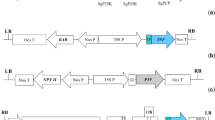Abstract
Spodoptera frugiperda (IPLB-SF-21) insect cells were grown in shake-flasks and infected with a temperature-sensitive baculovirus to express the gene of chloramphenicol acetyl transferase (CAT) in serum-free medium (SF-900) and two serum-supplemented media (IPL-41 and Grace's). In temperature-shift experiments (cell growth at 33°C followed by virus replication at 27°C 3–4 days later), virus and CAT production were much poorer in the serum-free medium than in serum-supplemented media, though cell growth was virtually the same in the different media tested. In all the three media, highest virus and CAT titers were obtained at the lowest MOI (multiplicity of infection 0.02). This result is contrary to that obtained in constant-temperature culture (27°C for both cell growth and virus replication). Virus and CAT production was greatly improved when the entire culture was run at constant temperature. It appeared that infected cells were severely damaged at 33°C (6°C above the optimal 27°C), resulting in little or no virus and protein production. As a result of these temperature-shift experiments, a larger-scale (141 air-lift bioreactor) serum-free culture of Sf-9 insect cells was conducted at constant temperature (27°C) to produce recombinant protein (β-galactosidase). A cell density as high as 1×107 cells.ml−1, and a β-gal concentration of up to 104,000 unit.ml−1 were achieved.
Similar content being viewed by others
References
Brown M and Faulkner P (1978) Plaque assay of nuclear polyhedrosis viruses in cell culture. Appal. Environm. Microbiol. 36: 31–35.
Hink WF and Strauss E (1976) Growth of theTrichoplusia ni (TN-368) cell line in suspension culture. In: Kurstak E and Maramorosch K (eds.) Invertebrate Tissue Culture: Applications in Medicine, Biology, and Agriculture. Academic Press, New York, pp. 297–300.
King G, Kuzio J, Daugulis A, Faulkner P, Alien B, Wu J and Goosen M (1991) Assessment of virus production and chloramphenicol acetyl transferase expressed by insect cells in serum-free and serum-supplemented media using a temperature-sensitive baculovirus. Biotechnol. Bioeng. 38: 1091–1099.
Luckow VA (1991) Cloning and expression of heterologous genes in insect cells with baculovirus vectors. In: Prokop A, Bajpai RK and Ho CS (eds.) Recombinant DNA Technology and Applications. McGraw-Hill, Inc., New York, pp. 97–152.
Maiorella B, Inlow D, Shauger A and Harano D (1988) Largescale insect cell-culture for recombinant protein production. Bio/Technology 6: 1406–1410.
Maniatis T, Fritsch EF and Sambrook J (1982) Molecular Cloning, 1st edn. Cold Spring Harbor, NY.
Miller GL (1959) Use of dinitrosalicylic acid reagent for determination of reducing sugar. Analytical Chemistry 3: 426–428.
Miller JH (1972) Experiments in molecular genetics Cold Spring Harbor Laboratory, New York.
Neumann JR, Morency CA and Russian KS (1987) A novel rapid assay for chloramphenicol acetyl transferase gene expression. Biotechniques 5 (5): 4440–450.
Potter KW and Miller LK (1980) Transfection of two invertebrate cell lines with DNA ofAutographa californica nuclear polyhedrosis virus. J. Invert. Pathol. 36: 431–435.
Weiss SA, Belisle BW, DeGovanini A, Godwin G, Kohler J and Summers MD (1989) Insect cells as substrates for biologicals. Develop. Biol. Standard. 70: 271–279.
Weiss SA, Gorfien S, Fike R, Disorbo D and Dayme D (1990) Large-scale production of proteins using serum-free insect cell culture. Presented at the Ninth Australian Biotechnology Conference, Cold Coast, Queensland, Australia.
Williams GV, Rohel DZ, Kozio J and Faulkner P (1989) A cytopathological investigation ofAutographa californica nuclear polyhedrosis virus (AcNPV) p10 gene function using insertion/deletion mutants. J. Gen. Virol. 70: 187–202.
Author information
Authors and Affiliations
Rights and permissions
About this article
Cite this article
Wu, J., King, G.A., Daugulis, A.J. et al. Recombinant protein production in insect cell cultures infected with a temperature-sensitive baculovirus. Cytotechnology 9, 141–147 (1992). https://doi.org/10.1007/BF02521741
Received:
Accepted:
Issue Date:
DOI: https://doi.org/10.1007/BF02521741




